This post may contain affiliate links. For more information, please see our affiliate policy.
Cornish Hen should be trussed before roasting to ensure even oven-roasting and supremely succulent, tender meat. Here’s how to do it; it only takes a minute and a length of kitchen twine.
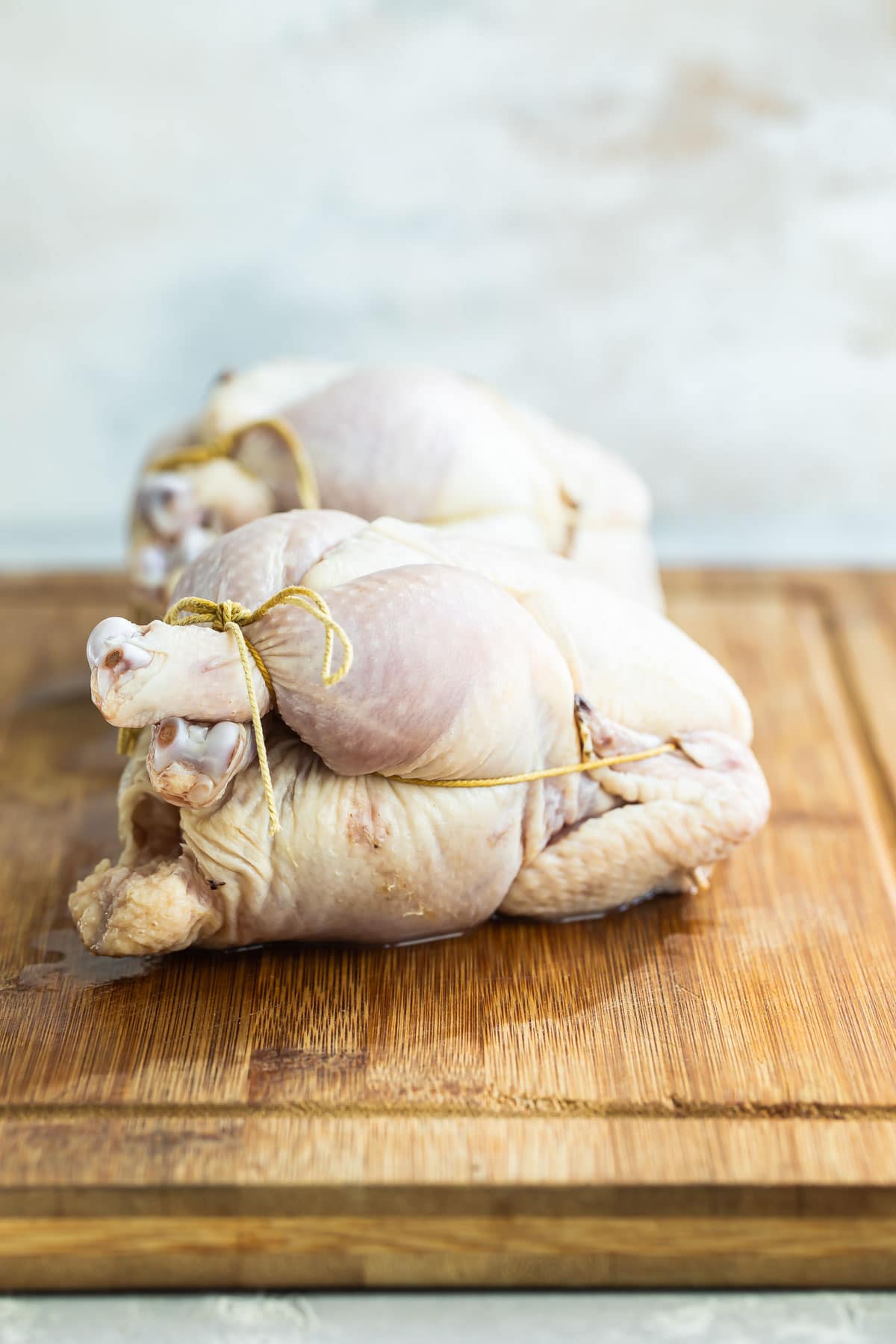
Just like roasted chickens and roasted turkeys, Cornish hens should be trussed for optimal results.
This ensures the bird cooks more quickly and evenly without drying out. It’s a simple technique that you can master, and suddenly you’ll find yourself trussing all the poultry in your life.
Table of Contents
Trussing notes
- Twine: Seek out unbleached cotton kitchen twine, also known as butcher’s twine, which is strong enough to hold a chicken together but won’t burn. Most butchers keep this on hand so you can simply ask for a long piece at the counter while you’re ordering your meat so you’ll always have some on hand. (Alternatively, you can buy your own at retailers like HomeGoods or on Amazon; I buy this twine.)
- Cornish hen: Also known as a Cornish game hen or Rock Cornish Hen, this type of poultry is a bit smaller than a standard chicken, usually under 2 pounds. But you can use this technique on any type or size of poultry you like; just cut more twine.
Step-by-step instructions
- Place the hen breast-side up, with tail end facing you. Fold and tuck the wings against the bird, and run the center of the string under the neck in the front of the bird.
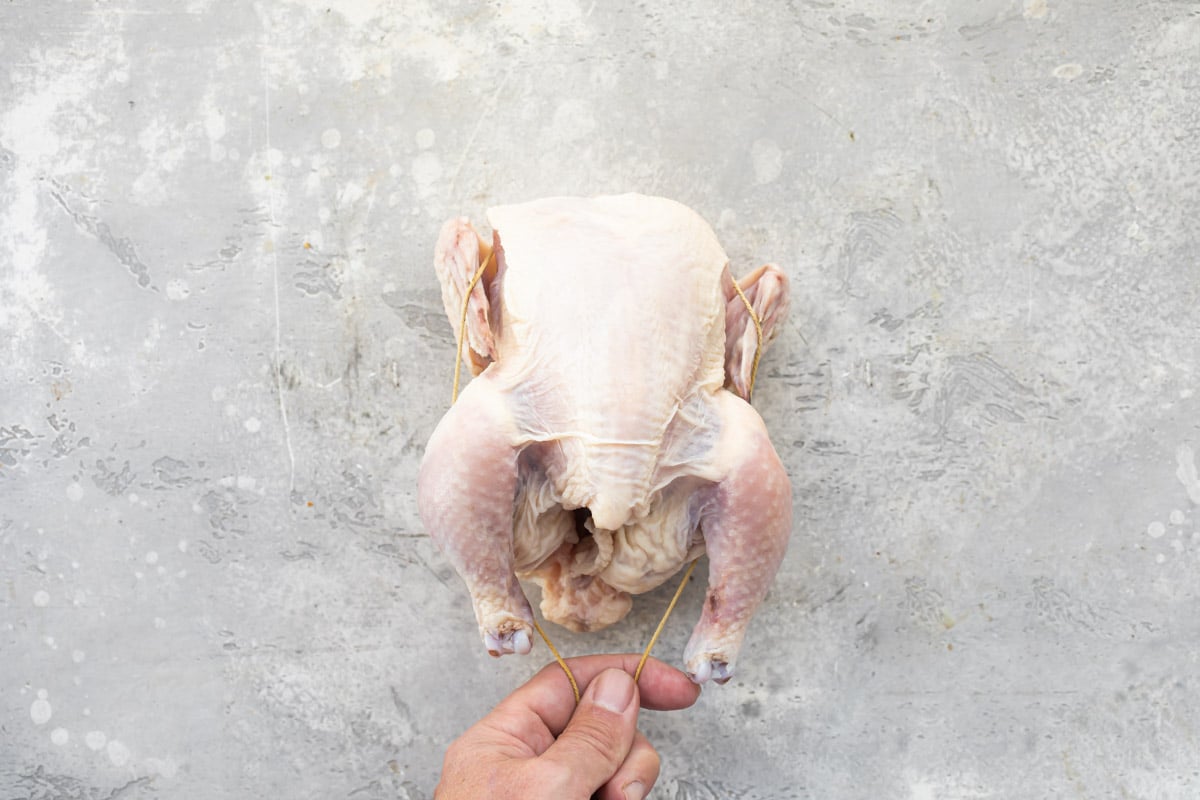
- Bring the string up towards the wings and legs. Use your thumbs to tuck the wings back as you bring the string around towards the legs. Keep the string tight to force the wings firmly against the hen. The string should roughly follow the contours of the chicken breast. Bring the string around between leg and breast, then give it one overhand knot and pull tight. The wings will be solidly pinned down, and the hen’s breast will pop up. Note that this is NOT a solid knot – we just want to be able to tighten up on the string.
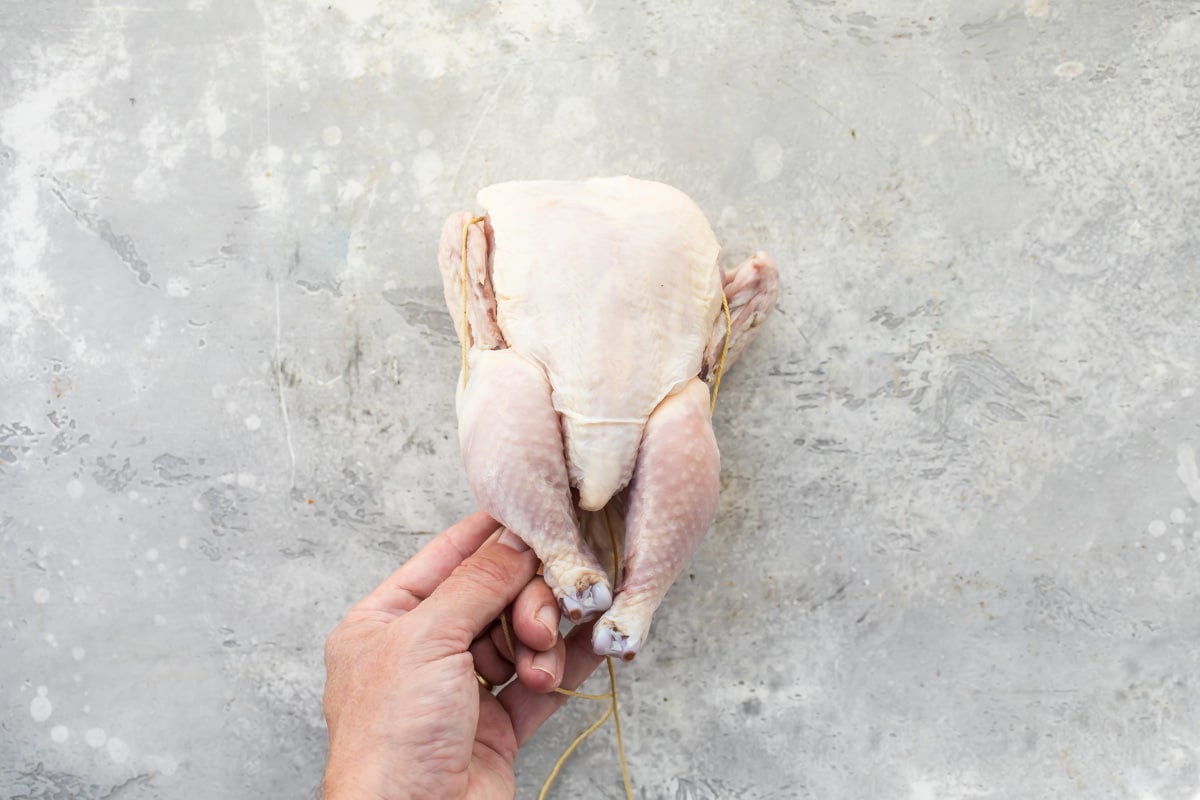
- Bring the ends of string down between the chicken’s legs, then cross the legs at the “ankles” above/behind the point of the hen’s breast. Make sure your previous knot is still pulled tight. Separate the strings, loop them around the outside of the hen’s ankles, then tie a square knot to finish it off. The legs should now be cinched in close to the body. Cut the extra ends of string with a knife or scissors and discard them.
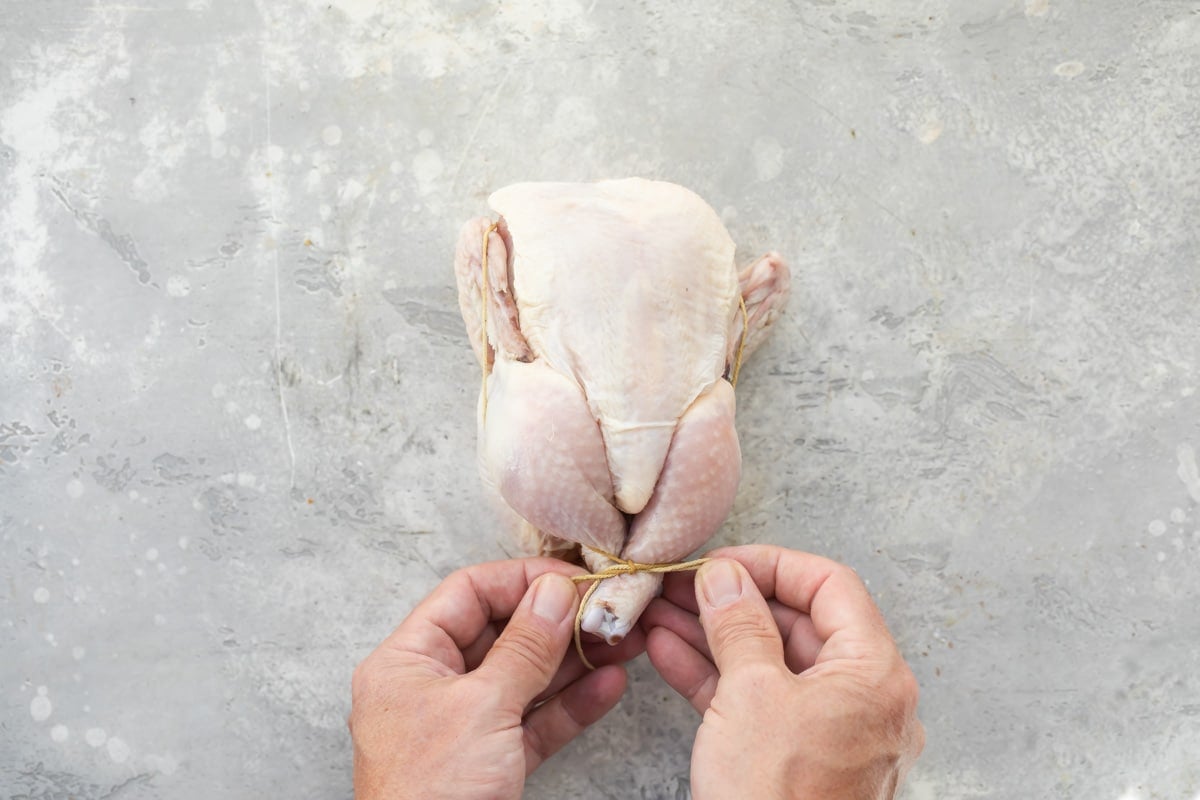
Recipe tips and variations
- Thaw completely: If you bought a frozen hen, make sure it is safely thawed before trussing and roasting. Thaw a frozen hen in a small bowl of cold water for 1-2 hours (changing the water every 30 minutes) or in the fridge for 1-2 days before you need it. Make sure you place them on a tray to catch any liquid that leaks out of the packaging. Never leave frozen poultry out at room temperature, and never use warm water for thawing.
- Stuff with herbs: Any roasted bird tastes even better with some fresh rosemary sprigs, fresh thyme, cloves of garlic, and lemon wedges tucked inside the cavity. Rub the outside of the birds with olive oil or butter, then sprinkle with kosher salt and freshly ground black pepper. For a complete meal, fill the roasting pan with potatoes and onions.
- Make ahead: It’s okay to truss the hen a day or two before you plan to roast it; just cover and store in the refrigerator.
- Folded wings technique: This method is a little less tricky, and depending on the size of the hen, sometimes I do it this way, too: Working one at a time, grasp a wing and gently fold it away from you, tucking under the body to secure it. After that, just tie the drumsticks together with kitchen twine. (A bow helps so you can untie it after it’s roasted.)
- To serve: Always remove the trussing twine before serving Cornish hens to your guests. Personally I love the look of a trussed bird, but things can get messy if people are unwinding twine by hand at the dinner table.
- Leftovers: If you’re lucky enough to have extra meat from your Cornish hens, it’s delicious in a salad, on a sandwich, or turned into soup with chicken broth. For extra flavor, garnish your soup with lemon juice, sprigs of fresh cilantro, and hot sauce.
- How to Roast a Cornish Hen: See my recipe for Cornish Hens with Stuffing, a delicious dinner idea and part of my Thanksgiving for Two recipe collection.
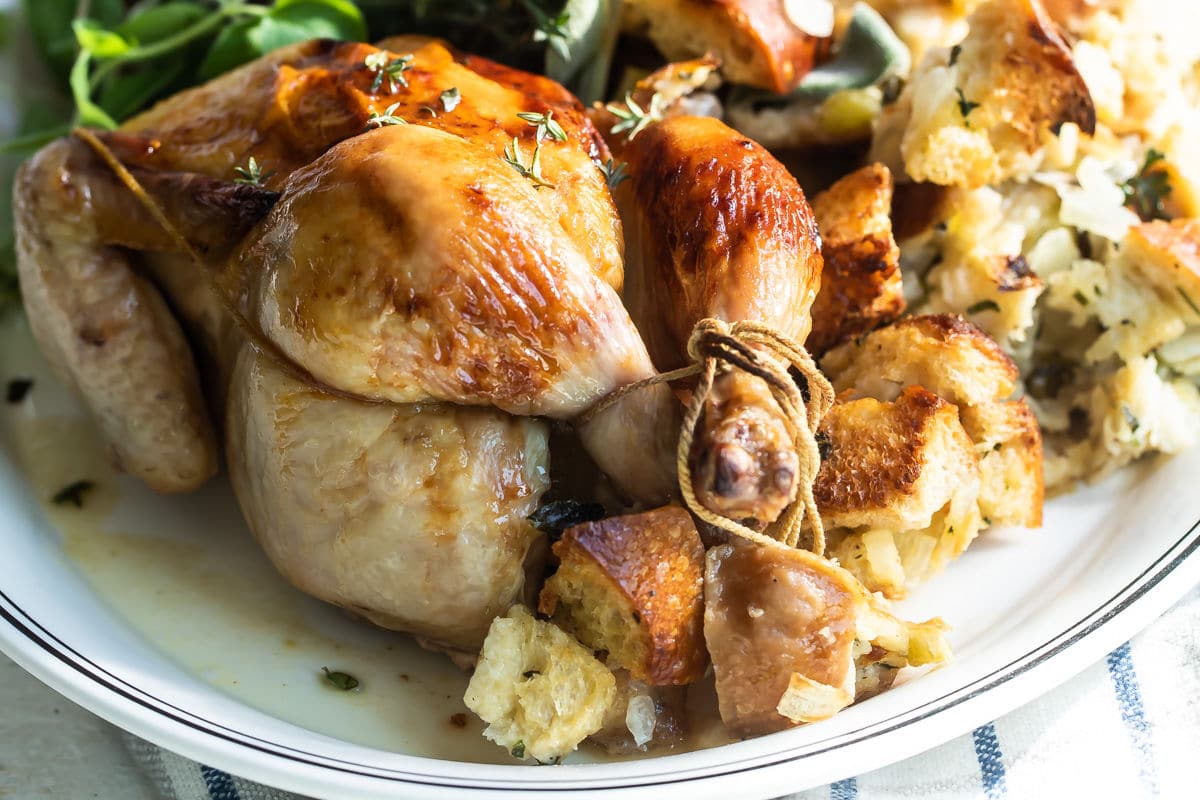
Frequently Asked Questions
Trussing Cornish hens, or any poultry, is never required. But, doing so ensures your bird cooks evenly without drying out. Trussing fulls under the “optional but recommended” category.
You’ll want to roast your Cornish hens until at least 170 degrees, or even 180 degrees, when a thermometer is inserted at the thickest part of the thigh. The thighs take the longest to cook, so always test at that spot.
Protect poultry skin with a layer of aluminum foil in the oven.
More birds to truss
Thanksgiving Recipes
Perfect Roast Turkey
Chicken and Turkey Recipes
How to Make Rotisserie Chicken
Thanksgiving Recipes
Make Ahead Roasted Turkey
Join Us
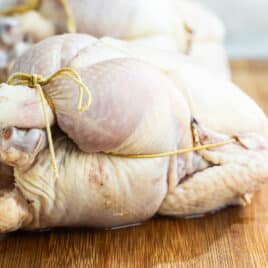
How to Truss a Cornish Hen
Equipment
- 2 feet kitchen twine (see note 1)
Ingredients
- 1 (1 ¼ to 1 ½ pound) cornish game hen thawed (see notes 2 & 3)
Instructions
- Cut a length of kitchen twine about 2 feet long. Place the hen breast-side up, with tail end facing you. Fold and tuck the wings against the bird, and run the center of the string under the neck in the front of the bird. Bring the string up towards the wings and legs.
- Use your thumbs to tuck the wings back as you bring the string around towards the legs. Keep the string tight to force the wings firmly against the hen. The string should roughly follow the contours of the chicken breast.
- Bring the string around between leg and breast, then give it one overhand knot and pull tight. The wings will be solidly pinned down, and the hen's breast will pop up. Note that this is NOT a solid knot – we just want to be able to tighten up on the string.
- Bring the ends of string down between the chicken's legs, then cross the legs at the "ankles" above/behind the point of the hen's breast. Make sure your previous knot is still pulled tight.
- Separate the strings, loop them around the outside of the hen's ankles, then tie a square knot to finish it off. The legs should now be cinched in close to the body. Cut the extra ends of string with a knife or scissors and discard them.
Notes
- Twine: Unbleached cotton kitchen twine, also known as butcher’s twine, is strong enough to hold a turkey together but won’t burn. Pro tip: You can ask your butcher for a long piece so you’ll always have some on hand. Sometimes I find it at HomeGoods or on Amazon.
- Cornish hen: Also known as a Cornish game hen or Rock Cornish Hen, this type of poultry is a bit smaller than a standard chicken, usually under 2 pounds. But you can use this technique on any type or size of poultry you like; just cut more twine.
- Thaw completely: If you bought a frozen hen, make sure it is safely thawed before trussing and roasting. Thaw a frozen hen in a small bowl of cold water for 1-2 hours (changing the water every 30 minutes) or in the fridge for 1-2 days before you need it. Make sure you place them on a tray to catch any liquid that leaks out of the packaging. Never leave frozen poultry out at room temperature, and never use warm water for thawing.
Nutrition
Meggan Hill is a classically-trained chef and professional writer. Her meticulously-tested recipes and detailed tutorials bring confidence and success to home cooks everywhere. Meggan has been featured on NPR, HuffPost, FoxNews, LA Times, and more.
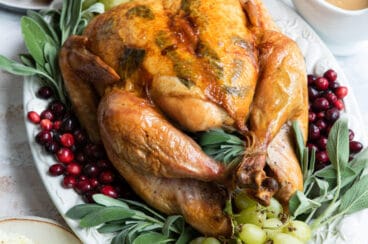
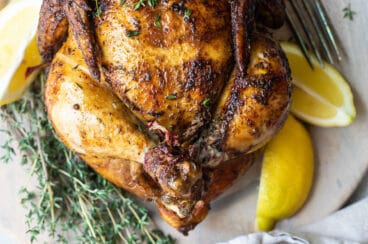
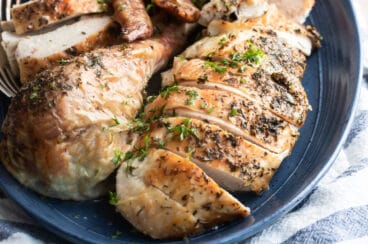
Thank you for this idea, Meggan! The number of guests that I usually entertain is shrinking and serving Cornish game hens should be perfect!
You’re so welcome, Maureen! If you are looking for a recipe on cooking them, check out my Cornish Hens with stuffing! The apple glaze is delicious! https://www.culinaryhill.com/cornish-hens-with-stuffing/ Take care! – Meggan
This will make things easy when I make them! Thank you!